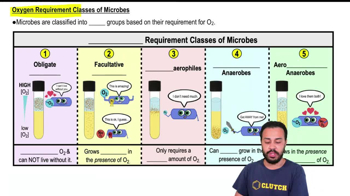Table of contents
- 1. Introduction to Biology2h 40m
- 2. Chemistry3h 40m
- 3. Water1h 26m
- 4. Biomolecules2h 23m
- 5. Cell Components2h 26m
- 6. The Membrane2h 31m
- 7. Energy and Metabolism2h 0m
- 8. Respiration2h 40m
- 9. Photosynthesis2h 49m
- 10. Cell Signaling59m
- 11. Cell Division2h 47m
- 12. Meiosis2h 0m
- 13. Mendelian Genetics4h 41m
- Introduction to Mendel's Experiments7m
- Genotype vs. Phenotype17m
- Punnett Squares13m
- Mendel's Experiments26m
- Mendel's Laws18m
- Monohybrid Crosses16m
- Test Crosses14m
- Dihybrid Crosses20m
- Punnett Square Probability26m
- Incomplete Dominance vs. Codominance20m
- Epistasis7m
- Non-Mendelian Genetics12m
- Pedigrees6m
- Autosomal Inheritance21m
- Sex-Linked Inheritance43m
- X-Inactivation9m
- 14. DNA Synthesis2h 27m
- 15. Gene Expression3h 20m
- 16. Regulation of Expression3h 31m
- Introduction to Regulation of Gene Expression13m
- Prokaryotic Gene Regulation via Operons27m
- The Lac Operon21m
- Glucose's Impact on Lac Operon25m
- The Trp Operon20m
- Review of the Lac Operon & Trp Operon11m
- Introduction to Eukaryotic Gene Regulation9m
- Eukaryotic Chromatin Modifications16m
- Eukaryotic Transcriptional Control22m
- Eukaryotic Post-Transcriptional Regulation28m
- Eukaryotic Post-Translational Regulation13m
- 17. Viruses37m
- 18. Biotechnology2h 58m
- 19. Genomics17m
- 20. Development1h 5m
- 21. Evolution3h 1m
- 22. Evolution of Populations3h 52m
- 23. Speciation1h 37m
- 24. History of Life on Earth2h 6m
- 25. Phylogeny2h 31m
- 26. Prokaryotes4h 59m
- 27. Protists1h 12m
- 28. Plants1h 22m
- 29. Fungi36m
- 30. Overview of Animals34m
- 31. Invertebrates1h 2m
- 32. Vertebrates50m
- 33. Plant Anatomy1h 3m
- 34. Vascular Plant Transport2m
- 35. Soil37m
- 36. Plant Reproduction47m
- 37. Plant Sensation and Response1h 9m
- 38. Animal Form and Function1h 19m
- 39. Digestive System10m
- 40. Circulatory System1h 57m
- 41. Immune System1h 12m
- 42. Osmoregulation and Excretion50m
- 43. Endocrine System4m
- 44. Animal Reproduction2m
- 45. Nervous System55m
- 46. Sensory Systems46m
- 47. Muscle Systems23m
- 48. Ecology3h 11m
- Introduction to Ecology20m
- Biogeography14m
- Earth's Climate Patterns50m
- Introduction to Terrestrial Biomes10m
- Terrestrial Biomes: Near Equator13m
- Terrestrial Biomes: Temperate Regions10m
- Terrestrial Biomes: Northern Regions15m
- Introduction to Aquatic Biomes27m
- Freshwater Aquatic Biomes14m
- Marine Aquatic Biomes13m
- 49. Animal Behavior28m
- 50. Population Ecology3h 41m
- Introduction to Population Ecology28m
- Population Sampling Methods23m
- Life History12m
- Population Demography17m
- Factors Limiting Population Growth14m
- Introduction to Population Growth Models22m
- Linear Population Growth6m
- Exponential Population Growth29m
- Logistic Population Growth32m
- r/K Selection10m
- The Human Population22m
- 51. Community Ecology2h 46m
- Introduction to Community Ecology2m
- Introduction to Community Interactions9m
- Community Interactions: Competition (-/-)38m
- Community Interactions: Exploitation (+/-)23m
- Community Interactions: Mutualism (+/+) & Commensalism (+/0)9m
- Community Structure35m
- Community Dynamics26m
- Geographic Impact on Communities21m
- 52. Ecosystems2h 36m
- 53. Conservation Biology24m
8. Respiration
Types of Phosphorylation
Problem 3
Textbook Question
Textbook QuestionThe final electron acceptor of the electron transport chain that functions in aerobic oxidative phosphorylation is a. oxygen. b. water. c. NAD+. d. pyruvate.
 Verified step by step guidance
Verified step by step guidance1
Identify the process being discussed: The question refers to the electron transport chain in aerobic oxidative phosphorylation, which is a key part of cellular respiration occurring in the mitochondria.
Understand the role of the electron transport chain: It involves a series of electron carriers that pass electrons derived from nutrients to progressively more electronegative carriers, ultimately transferring them to a final electron acceptor.
Recall the final electron acceptor: In aerobic conditions, the final electron acceptor must be a molecule that can efficiently accept electrons and combine with protons to form a stable product.
Analyze the options given: Oxygen (a) is known to accept electrons and protons to form water, a stable molecule, at the end of the electron transport chain. Water (b) is a product, not an acceptor. NAD+ (c) and pyruvate (d) are involved earlier in respiration, not at this stage.
Recommended similar problem, with video answer:
 Verified Solution
Verified SolutionThis video solution was recommended by our tutors as helpful for the problem above
Video duration:
3mPlay a video:
Was this helpful?
Key Concepts
Here are the essential concepts you must grasp in order to answer the question correctly.
Electron Transport Chain (ETC)
The electron transport chain is a series of protein complexes and other molecules located in the inner mitochondrial membrane. It plays a crucial role in cellular respiration by transferring electrons from electron donors like NADH and FADH2 to electron acceptors. This process generates a proton gradient that drives ATP synthesis through oxidative phosphorylation.
Recommended video:
Guided course

Electron Transport Chain
Aerobic Oxidative Phosphorylation
Aerobic oxidative phosphorylation is the final stage of cellular respiration, where ATP is produced using energy derived from the transfer of electrons through the ETC. Oxygen serves as the final electron acceptor, allowing for the formation of water as a byproduct. This process is essential for the efficient production of ATP in aerobic organisms.
Recommended video:
Guided course

Oxidative Phosphorylation
Role of Oxygen
Oxygen is vital in aerobic respiration as it acts as the final electron acceptor in the electron transport chain. When electrons are transferred to oxygen, it combines with protons to form water, which is crucial for maintaining the flow of electrons through the chain. Without oxygen, the entire process of aerobic respiration would halt, leading to a significant decrease in ATP production.
Recommended video:
Guided course

Oxygen Requirement Classes of Microbes

 1:06m
1:06mWatch next
Master Types of Phosphorylation with a bite sized video explanation from Jason Amores Sumpter
Start learningRelated Videos
Related Practice









